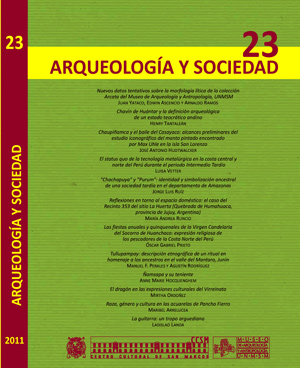CHAUPIÑAMCA AND CASAYACO DANCING: PRELIMINARY STUDY OF ICONOGRAPHIC MANTLE FOUND BY MAX UHLE ON THE ISLAND SAN LORENZO
DOI:
https://doi.org/10.15381/arqueolsoc.2011n23.e12309Keywords:
San Lorenzo Island, Max Uhle, Ichma style, painted mantle, iconography, dance of Casayaco, Chaupiñamca, Rucanacoto, fertility and prosperity.Abstract
In 1907, Max Uhle performed excavations at the La Cruz Creek, located in the San Lorenzo Island. One of the most important objects discovered during that exploration was a mantle with a painting representing a parade of naked people. The painted mantle and other objects retrieved from the island by Uhle are kept at the Museo Nacional de Arqueología, Antropología e Historia del Perú. The iconographic study was based on a semiologic approach. As long as the characters, their attrbutes and their actions are properly identified, this approach leads to fine results on the meaning of the representations. Chronologically, the mantle pertains to the Late Horizon (1470-1532 dC.) and culturally is related to the Ichma style, from the Rimac and Lurín valleys. The Ichma style shares some features with northern styles such as Chancay, Chimú and Lambayeque. The mantle was compared to the data offered by the Manuscript of Huarochirí regarding the dance of Casayaco, a celebration in honor of the goddess Chaupiñamca. Although it cannot be ascertained with certainty that the mantle represents that dance, the iconographic analysis provided strong arguments in order to establish a relationship between the representation of the mantle and the rituals in honor of that divinity. Therefore, the design of the mantle may be an incitement to the fertility of the land and to the prosperity of the community.Downloads
Published
Issue
Section
License
Copyright (c) 2011 José Antonio Hudtwalcker Morán

This work is licensed under a Creative Commons Attribution-NonCommercial-ShareAlike 4.0 International License.
THE AUTHORS RETAIN THEIR RIGHTS:
a. The authors retain their trademark and patent rights, and also on any process or procedure described in the article.
b. The authors retain the right to share, copy, distribute, perform and publicly communicate the article published in the Arqueología y Sociedad (for example, place it in an institutional repository or publish it in a book), with an acknowledgment of its initial publication in the Arqueología y Sociedad.
c. The authors retain the right to make a subsequent publication of their work, to use the article or any part of it (for example: a compilation of their works, notes for conferences, thesis, or for a book), provided that they indicate the source. of publication (authors of the work, journal, volume, number and date).






